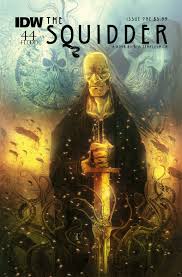 The Squidder #1
The Squidder #1
Publisher: IDW
Story: Ben Templesmith
Pencils: Ben Templesmith
Inks: Ben Templesmith
Colors: Ben Templesmith
Letters: Ben Templesmith
Ben Templesmith takes on the role of the Renaissance man with this first issue of his creator-owned comic The Squidder, in which he not only delivers his trademark art, but also colors his own work, writes the story, and even does the lettering.
The art here is simply fantastic. I’ve missed Templesmith ever since he left Ten Grand, so it’s really nice to see his return. Templesmith’s style is a little difficult to explain, as it doesn’t follow traditional comic conventions (especially from the “Big Two”). Figures are exaggerated, and there’s a loose, dare I say “cartoony,” style about the art that juxtaposes with the horrific subject matter in most of Templesmith’s works in a way that makes us feel uncomfortable. Figures that look like this shouldn’t be doing the things that they do, and that all adds more to the feeling of anxiety and unease as we move through the story.
All of this is helped with the limited color palette Templesmith uses. His dark, muted tones of purple, green, red, and a sickeningly pale yellow-brown color all immediately convey that this is an ailing, dying world that once was probably vibrant and full of hope. It takes a true master like Templesmith to help communicate that simply by use of his coloring.
So, what kind of world is this exactly? The Squidder is a mash-up type of comic that’s currently in vogue, defying traditional genre conventions. It’s probably best described as a Post-Apocalyptic Cthulhu Western Horror piece, with some zombie and science-fiction elements thrown in. And yet, this kitchen sink approach really works in this book.
The first issue is mainly about world building and a bit of character development. Templesmith dives right in, in the first few pages establishing how the world came to be the way it is, and then with the remaining pages showing us what the new norm is in terms of human civilization and interactions. He provides a bit of history along the way, with notes on religion, war, and government in this post-apocalyptic nightmare world. All of this is done with an economy of words. While there are a few pages with quite a bit of dialogue between the main character, the Squidder, and a man who we can assume will be the primary antagonist throughout this first story arc, the remainder of the story uses crisp, efficient narration to communicate Templesmith’s world and what’s at stake.
The main character, the Squidder, is a down on his luck former soldier who may or may not be the last of his company, and even the last of his entire army, trying to make his way in a world that lost a war and is now trying to move on in the wake of the disaster. There’s a sort of Clint Eastwood “Man with No Name” element to the character, combined with the weary aging soldier personae as seen in a variety of military movies. He’s relatable but still quite a bit of a mystery, and Templesmith makes us want to learn more about him and his history.
There’s so much to like in this book, especially the art and the world creation that Templesmith is doing. The combination of different genres all works well together to make a fascinating, if bleak, world that we want to understand better in the future issues.
Martin Thomas
@comicattack.net


